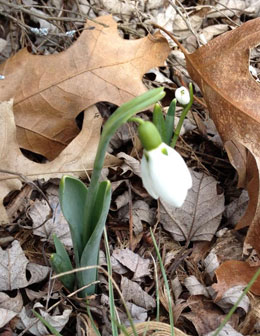Nature's Notebook allows you to keep track of seasonal changes
Learn about the USA National Phenology Network and Nature’s Notebook program at the upcoming family forest workshop during MSU’s Ag and Natural Resources Week.
 Did you hear the good news? Earlier this month, Punxsutawney Phil didn’t see his shadow. This means, according to Groundhog Day legend, that spring is right around the corner. Sure enough, other signs of spring are peeking through—tufted titmice and cardinals are beginning to practice their songs, and buds are starting to swell.
Did you hear the good news? Earlier this month, Punxsutawney Phil didn’t see his shadow. This means, according to Groundhog Day legend, that spring is right around the corner. Sure enough, other signs of spring are peeking through—tufted titmice and cardinals are beginning to practice their songs, and buds are starting to swell.
From one year to the next, Michigan residents often make it a habit of looking for different seasonal signs that native plants and animals reveal to us. Birdwatchers look for their favored migratory birds. Maple syrup producers prepare for the sap flow. Morel mushroom hunters get ready for their search with a good rain event. Many Michigan festivals depend on a specific plant flowering or fruiting during a specific time of year (think Mackinac Island’s lilac festival and Traverse City’s cherry festival).
Not surprisingly, there is a technical term for this annual life cycle process. It’s called phenology. Some refer to it as “nature’s calendar.” Every year, plants bud, leaf out and flower, animals migrate, mate and reproduce, and insects emerge at certain times of the year under certain combinations of light, temperature and moisture. Scientists and amateurs alike take the time to record these events from year to year, attempting to understand the relationships between these events and our weather and climate patterns.
Why is this important to understand? It relates in part to the changing climate. For example, on average, plants are sprouting and blooming earlier, and some insects are remaining active much later in the season. The challenge is that not every plant and animal is responding to these changes at the same rate. Although some plants may be flowering earlier, the pollinators they depend on — like bees and flies — may not yet be active. What does this mean for that plant’s ability to produce seed, spread and survive over time?
To better understand what is changing and what challenges our ecosystems may be facing, the USA National Phenology Network has developed a program for “citizen scientists” called Nature’s Notebook. This nationwide program teaches individuals how to collect data on plants’ and animals’ annual cycles, and offers a central clearinghouse on this information by species for anyone who is interested in knowing more about what is happening across the landscape. Nature’s Notebook also gives family forest owners a chance to gain a greater connection with their land and what lives there.
Want to learn more about Nature’s Notebook and how to get involved? Sign up for the daylong workshop A Toolbox of Opportunities for Family Forest Owners scheduled during Michigan State University’s Agriculture and Natural Resources Week. The program will take place Monday, March 4 from 9 a.m. to 3 p.m. Natural resource professionals from Michigan State University Extension and the Michigan Forest Association will also give updates on the latest tax programs and laws, and basic ideas on how to manage woodlands for wildlife habitat. The workshop will take place at the Kellogg Center on MSU’s campus in East Lansing, Mich. The registration fee of $35 per person covers lunch and take-home materials. For more information or to register for the workshop, contact Georgia Peterson at 517-353-9435 or petersog@msu.edu.



 Print
Print Email
Email




